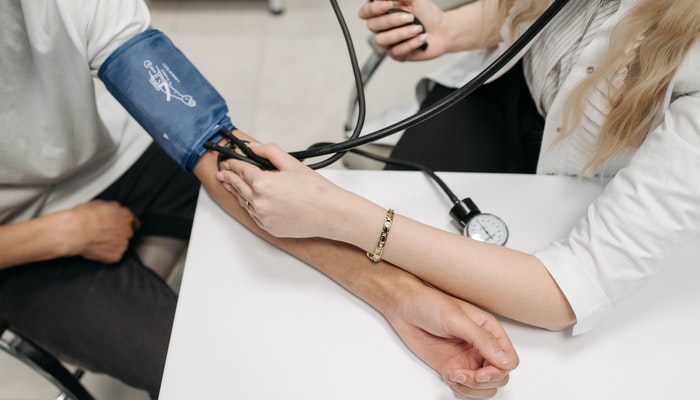High blood pressure (hypertension) is called a “silent killer”. Often do not have symptoms but is the main risk of heart disease and stroke. And this disease is one of the main causes of death around the world. It is estimated that 1.28 billion adults aged 30-79 years worldwide have hypertension, most (two-thirds) who live in low and medium income countries.
Your blood pressure is measured in a mercury millimetre, abbreviated as mm Hg. There are two numbers involved in the measurement:
• Systolic blood pressure: The first number represents the strength of the pressure when your heart pushes blood to the arteries throughout your body.
• Diastolic blood pressure: The second number represents the pressure in your blood vessels between the beats when your heart fills and relaxes.
Your blood pressure depends on how much blood is pumped by your heart, and how much resistance to blood flow in your arteries. The narrower your arteries, the higher your blood pressure.
Blood pressure level
Normal systolic: less than 120 mm Hg Diastolic: less than 80 mm Hg
At risk (prehypertension) systolic: 120-139 mm Hg Diastolic: 80-89 mm Hg
High blood pressure (hypertension) systolic: 140 mm Hg or higher diastolic: 90 mm Hg or higher
The good news about hypertension is that you can make changes to significantly reduce your number and reduce the risk naturally without the need for drugs.
Make these 10 lifestyles change to lower your blood pressure and reduce the risk of your heart disease.
If you have been diagnosed with high blood pressure, you might worry about taking medicine to reduce your numbers.
Lifestyle plays an important role in treating your high blood pressure. If you succeed in controlling blood pressure with a healthy lifestyle, you can avoid, delay or reduce drug needs.
Here are 10 changes in lifestyle that you can make to lower blood pressure and hold it.
1. Make sure you follow a healthy diet
Eating a diet that is rich in grains, fruits, vegetables, and low-fat milk products and skimmed in saturated fats and cholesterol can reduce your blood pressure to 11 mm Hg if you have high blood pressure. This eating plan is known as a food approach to stop the hypertensive diet (dash).
It’s not easy to change your eating habits, but with these tips, you can adopt a healthy diet:
• Save a food diary: Writing what you eat, even for only a week, can explain your surprising eating habits. Monitor what you eat, how much, when and why.
• Consider increasing potassium: Potassium can reduce the effect of sodium on blood pressure. The best source of potassium is food, such as fruits and vegetables, not supplements. Talk to your doctor about the best level of potassium for you.
• Be a smart shopper: Read the food label when you shop and stick to a healthy eating plan when you eat outside too.
The following is a list of some of the plants and herbs used by cultures around the world to reduce blood pressure:
• Black Bean (Castanospermeum Australe)
• Cat claws (Uncaria Rhynchophylla)
• Celery Juice (Apium Graveolens)
• China Hawthorn (Crataegus Pinnativea)
• Ginger roots
• Giant Dodder (Cuscuta Reflexa)
• Plantago India (blonde)
• Maritime pine skin (pine pinaster)
• River Lily (Crinum Glaucum)
• Roselle (Hibiscus sabdariffa)
• Sesame oil (sesamum indicum)
• Tomato Extract (Lycopersicon esculentum)
• Tea (Camellia Sinensis), especially Green Tea and Oolong Tea
• Umbrella tree bark (wealthy cecropioides)
2. Your diet must be low in sodium
Even a small reduction in sodium in your food can improve your heart health and reduce blood pressure by about 5 to 6 mm Hg if you have high blood pressure.
The effect of sodium intake on blood pressure varies between groups of people. In general, limit sodium to 2,300 milligrams (mg) a day or less. However, lower sodium intake – 1,500 mg a day or less – is ideal for most adults.
3. Consume alcohol as little as possible
Alcohol can be good and bad for your health. By drinking alcohol in just a medium amount is generally one drink a day for women, or two days for men, you have the potential to reduce your blood pressure by about 4 mm Hg. One drink is equal to 12 ounces of beer, five ounces of wine or 1.5 ounces of 80 – proof liquor.
But the protection effect is lost if you drink too much alcohol.
Drinking more than a moderate amount of alcohol can actually increase blood pressure by several points. This can also reduce the effectiveness of blood pressure drugs.
4. Say no to smoke
Every cigarette that you smoke increases your blood pressure for several minutes after you are finished. Stopping smoking helps your blood pressure back to normal. Stop smoking can reduce the risk of heart disease and improve your overall health. People who quit smoking may live longer than people who never stop smoking.
5. Reduce your caffeine intake
The role of caffeine that is played in blood pressure is still debated. Caffeine can increase blood pressure to 10 mm Hg in people who rarely consume them. But people who drink coffee regularly may experience little or no effect on their blood pressure.
Although the long-term effects of caffeine on blood pressure are not clear, maybe blood pressure may increase slightly.
To see if caffeine increases your blood pressure, check your pressure within 30 minutes after drinking caffeinated drinks. If your blood pressure increases 5 to 10 mm Hg, you may be sensitive to the effect of increasing caffeine blood pressure. Talk to your doctor about the effect of caffeine on your blood pressure.
6. Eat dark chocolate or cocoa
When eating large amounts of dark chocolate might not help your heart, a small amount is possible.
That’s because dark chocolate and cocoa powder are rich in flavonoids, which are plant compounds that cause blood vessels to widen.
The research review found that cocoa-rich flavonoids increased several heart health markers in the short term, including lowering blood pressure.
For the strongest effect, use non-alkalized cocoa powder, which is very high in flavonoids and does not have added sugar.
7. Relax and reduce your stress
Chronic stress can contribute to high blood pressure. More studies are needed to determine the effect of chronic stress on blood pressure. Stress occasionally can also contribute to high blood pressure if you react to stress by eating unhealthy foods, drinking alcohol or smoking.
Take time to think about what causes you to feel stressed, such as work, family, finance or disease. After you know what causes your stress, consider how you can eliminate or reduce stress.
8. Pay attention to your weight and lose that extra pound
Blood pressure often increases with weight gain. Being overweight can also cause disturbed breathing when you sleep (sleep apnea), which further increases your blood pressure.
Weight loss is one of the most effective changes in lifestyle for controlling blood pressure. Loss or even a little weight if you are overweight or obese can help reduce your blood pressure. In general, you can reduce your blood pressure by about 1 millimetre of mercury (mm Hg) with every kilogram (about 2.2 pounds) lost weight.
In addition to spilling pounds, you usually also have to watch your waist. Bringing too much weight in your waist can put you at a greater risk of high blood pressure.
In general:
• Men are at risk if their waist measurements are greater than 40 inches (102 centimetres).
• Women are at risk if their waist measurements are greater than 35 inches (89 centimetres).
These figures vary between ethnic groups. Ask your doctor about healthy waist measurements for you.
9. Involve in regular physical activity
Regular physical activity like 150 minutes a week, or about 30 minutes almost every day a week can reduce your blood pressure by about 5 to 8 mm Hg if you have high blood pressure. Important to be consistent because if you stop exercising, your blood pressure can rise again.
If you have high blood pressure, exercise can help you avoid developing hypertension. If you are already suffering from hypertension, regular physical activity can bring your blood pressure back to safer levels.
Some examples of aerobic exercises that you can try to reduce blood pressure include walking, jogging, cycling, swimming or dancing. You can also try high-intensity interval training, which involves alternating short gusts of intense activity with subsequent recovery periods of lighter activity. Force training can also help reduce blood pressure. Take aims to include strength training exercises at least two days a week. Talk to your doctor to develop an exercise program.
10. Make sure to monitor your blood pressure at home and consult your doctor regularly
Home monitoring can help you keep an eye on your blood pressure, make sure that your lifestyle changes work and alert you, as well as your doctor, to potential health complications. Blood pressure monitors are widely available and without a prescription. Talk to your doctor about home surveillance before you start.
Regular visits with your doctor are also essential to control your blood pressure. If your blood pressure is well controlled, check with your doctor the frequency you need to check. Your doctor may suggest checking this daily or less often. If you make changes to your medication or other treatments, your doctor may recommend that you check your blood pressure from two weeks after changes in treatment and a week before your next appointment.



